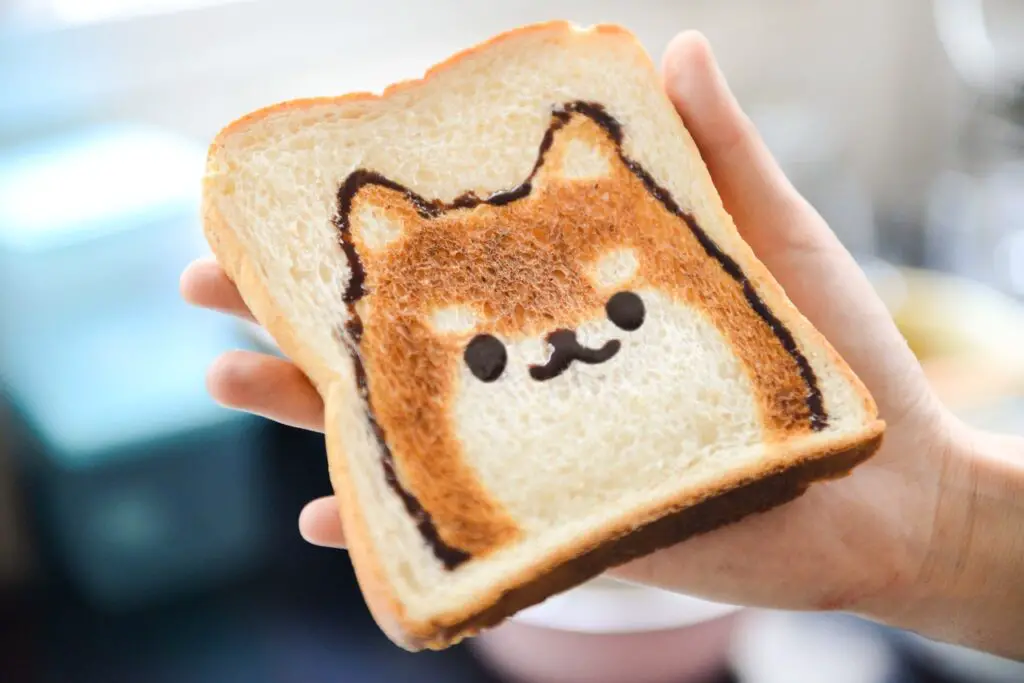Bread is a staple in our house. We all love it.
When it’s left on the counter our dog has a good sniff before one of us has to snatch it away. We’ve found that quite funny, but recently we’ve read a few posts that have made us re-think where we leave our bread-based snacks.
Human food can be toxic to dogs. Grapes, raisins and chocolate are the obvious ones to avoid but what would happen if my dog ate a loaf of bread? Would she be OK?
Before we jump in, we’re not veterinarians and nothing we say should be constituted as medical advice. This post is based on research and experience rather than professional opinion. Always be mindful of what your dog eats and if they’ve eaten something you’re worried about or are unsure of, contact your veterinarian.
What happens if a dog eats a loaf of bread?
Bread isn’t toxic to dogs and most won’t go on to develop any problems after eating it.
But some will.
Dogs with a grain intolerance may get an upset stomach from eating bread. Some dogs will show no signs of discomfort but may fart or poop more frequently afterwards. Other dogs can become constipated. Keep an eye on what’s happening with your dog’s bowel movements and their general behavior. Taking your dog on extra walks to encourage them to go to the toilet can help them settle more quickly.
The worry is that some dogs could develop bloat.
Dogs that eat a lot of food very quickly (like snaffling a loaf of bread) can be at risk of ‘food bloat’. This can happen with bread or even with dog food. According to Vet Babble, bloat is where the stomach fills with gas and air, rotates on itself and then twists at either end. It’s a very dangerous condition for dogs and can be fatal without veterinarian intervention. Some breeds are more susceptible to bloat than others.
The common signs to look out for in your dog are:
A distended stomach
Retching without being sick
Vomiting
Agitation or restlessness
Whining or moaning as if in pain
Drooling
Heavy breathing
If you spot any of these or if you’re worried your dog could have bloat, contact your veterinarian. Bloat is a very serious condition and healthy dogs can die from it very quickly.
You should also check if your dog ate any of the plastic wrappings when it ate the bread. If it did, call a veterinarian. Dogs can sometimes pass plastic wrapping naturally but it can also cause an obstruction.
It’s easy to forget but do try and keep bread in a cupboard or well away from prying paws. Having a few plain bread slices is unlikely to cause your dog much trouble but it’s better to keep it away from them entirely.
What About Flavored Bread?
Some loaves have added ingredients that are dangerous to our pets.
Raisins are toxic to dogs so keep raisin bread well away from your pet. Chocolate in bread can be dangerous, too. Some sweetened bread products may contain xylitol which is incredibly toxic to dogs. Xylitol is a sweetener that’s often used in low-sugar jelly and jam and can kill your pet. You should be careful about what’s been spread on the bread, too.
Can dogs eat raw bread dough?
No. Dogs should not eat raw bread dough.
If there is yeast or a baking agent in the dough, contact your veterinarian immediately. What happens is the yeast or baking powder makes the dough rise inside the dog’s stomach. This causes two serious problems: the stomach begins to swell and the bread dough releases ethanol which gets into the dog’s bloodstream and leads to alcohol toxicity which can easily become fatal. The American Kennel Club describes the symptoms of alcohol toxicity including:
Weakness
Depression
Unsteady, drunken gait
Hypothermia
Coma
My dog at a loaf of moldy bread
Moldy bread is another potential danger to dogs. Small amounts can be fine but dogs that have eaten a fair chunk of it could go on
to develop mycotoxin poisoning. Mycotoxin is the name for a type of mold that grows on old bread. It’s something that owners need to be careful of outside the home, too. For example, your dog could find an old loaf that someone has left behind in a field or inside an exposed trash can or bin. This kind of poisoning can happen with other household items too like cheese and fruit etc.
Pet Coach describes the common signs to watch out for as being
Vomiting
Agitation
Walking drunk
Tremors
Seizures
Severe secondary hyperthermia
If you suspect that your dog has eaten mouldy bread, contact your veterinarian immediately for advice.
As with many food-related dog questions, there’s a simple answer that will apply to many owners and a more complicated response that will apply to a few unfortunate ones.
A regular loaf of bread in itself isn’t toxic to dogs. Some owners give their pets the occasional slice as a treat without any problem. A cursory search on the internet also shows plenty of examples where dogs have eaten an entire loaf and been none the worse for it. It’s easy to jump to a worst-case scenario especially if you’ve never had a pet that’s eaten a loaf before. Whilst we can become easily terrified, it’s just the sign of a conscientious owner. We don’t want to scare anyone with all our talk of life-threatening conditions but knowledge makes us all better owners and of course, there are always exceptions.
Keeping human food away from our dogs, checking the ingredients on food packets and paying attention to changes in our dog’s behavior can help keep our pets safe in the home. Dog bloat can kill quickly, so if you’re in any doubt – call a veterinarian.

